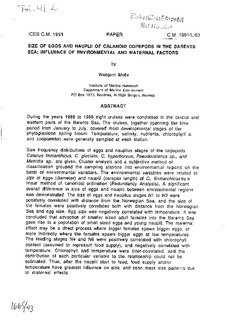| dc.description.abstract | During the years 1986 to 1988 eight cruises were conducted in the central and
western parts of the Barents Sea. The cruises, together spanning the time
period from January to July, covered most developmental stages of the
phytoplankton spring bloom. Temperature, salinity, nutrients, chlorophyll a,
and zooplankton were generally sampled at each station.
Size frequency distributions of eggs and nauplius stages of the copepods
Calanus finmarchicus, C. glacialis, C. hyperboreus, Pseudocalanus sp., and
Metridia sp., are given. Cluster analysis and a subjective method of
classification grouped the sampling stations into environmental regions on the
basis of environmental variables. The environmental variables were related to
size of eggs (diameter) and nauplii (carapax length) of C. finmarchicus by a
linear method of canonical ordination (Redundancy Analysis). A significant
overall difference in size of eggs and nauplii between environmental regions
was demonstrated. The size of eggs and nauplius stages N1 to N3 were
positively correlated with distance from the Norwegian Sea, and the size of
the females were positively correlated both with distance from the Norwegian
Sea and egg size. Egg size was negatively correlated with temperature. lt was
concluded that advection of smaller sized adult females into the Barents Sea
gave rise to a population of small sized eggs and young nauplii. The maternal
effect may be a direct process where bigger females spawn bigger eggs, or
more indirectly where the females spawn bigger eggs at low temperatures.
The feeding stages N4 and N6 were positively correlated with chlorophyll
content (assumed to represent food supply), and negatively correlated with
temperature. Chlorophyll and temperature were inter-correlated, and the
contribution of each particular variable to the relationship could not be
estimated. Thus, after the nauplii start to feed, food supply and/or
temperature have greatest influence on size, and soon mask size patterns due
to maternal effects. | no_NO |
